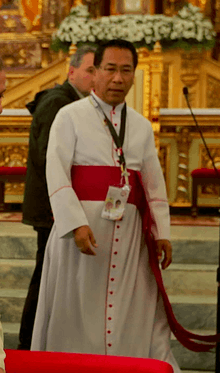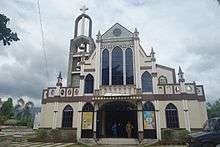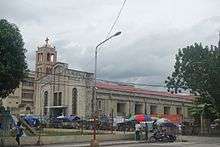Roman Catholic Archdiocese of Palo
| Archdiocese of Palo Archidioecesis Palensis Arkidiyosesis han Palo Arkidiyosesis sa Palo | |
|---|---|
|
| |
| Location | |
| Country | Philippines |
| Territory | Eastern Visayas except Southern Leyte |
| Ecclesiastical province | Leyte |
| Metropolitan | Palo, Leyte |
| Statistics | |
| Area | 4,620 km2 (1,780 sq mi) |
| Population - Total - Catholics |
(as of 2004) 1,572,472 1,257,977 (80%) |
| Information | |
| Denomination | Roman Catholic |
| Sui iuris church | Latin Church |
| Rite | Roman Rite |
| Established |
28 November 1937 (Diocese) 14 February 1982 (Archdiocese) |
| Cathedral | Metropolitan Cathedral of Our Lord's Transfiguration in Palo, Leyte |
| Patron saint | Transfiguration of Our Lord |
| Secular priests | 158 priests |
| Current leadership | |
| Pope | Francis |
| Metropolitan Archbishop | John Forrosuelo Du |
| Vicar General | Rex C. Ramirez, SLL |
| Emeritus Bishops | Pedro R. Dean Archbishop Emeritus (1985-2006) |
| Map | |
 Jurisdiction of the metropolitan see within the Philippines. | |
| Website | |
| Website of the Archdiocese | |
The Roman Catholic Archdiocese of Palo is a large administrative diocese of the Catholic Church in the town of Palo in Leyte province, Philippines. It was formed as a diocese on the 28th of November, 1937, and became an archdiocese in 1982, with Calbayog, Borongan, Catarman and Naval Diocese serving as suffragan to it. The archdiocese encompasses 4,620 km2 (1,780 sq mi) and an overwhelmingly Catholic population of 1,165,565. The archdiocese has two districts, Eastern and Western, which are divided among the languages Waray and Cebuano. The Eastern District has seven vicariates of 34 parishes. 13 parishes are in the Western District, with one chaplaincy. The archdiocese contains two seminaries. The elder of these is the Sacred Heart Seminary, which was founded in 1944. Founded in 1988, the St. John Evangelist School of Theology serves additional dioceses. Jose S. Palma, a priest from the Archdiocese of Jaro was the Archbishop of Palo until he was appointed as Archbishop of Cebu
The Archdiocese of Palo was created as a Diocese on November 28, 1937 and elevated to as Archdiocese November 15, 1982 with four neighboring dioceses of the Metropolitan, to include Borongan, Calbayog, Catarman and Naval.
History
The province of Leyte to which the Archdiocese of Palo belongs was the scene of the first Mass in the Philippines celebrated by Fr. Pedro de Valderrama on March 31, 1521, Easter Sunday. The exact spot is the small island Limasawa on the southernmost tip of Leyte Island. However, formal work of evangelization did not start until 74 years later when the Jesuits arrived in Kangara or Carigara, led by Fr. Pedro Chirino, S.J. with four priests and one brother companion on 16 July 1595. At that time there were settlements connected with each other by dirt roads. The missionaries had to work for the formation of the towns since the people were spread out over the lowlands and into the mountains. The population of about 70,000 came under the general control of local officials called encomenderos assigned to collect the tribute from the people. A constant difficulty the missionaries encountered in their efforts of spreading the Faith was the greediness of the tribute collectors and the carrying out of the Moro raids. These raids usually came during the monsoon season. The object of the raids was to capture slaves, to inflict physical damage to the towns and countryside, and to carry away any crop or booty. The captured slaves were to be later sold in Malaya, Macassar, or Java. The first major raid on record was made on October 28, 1603, composed of seventy ships and two thousand men. Palo and Dulag were burned, and captives were taken. A raid in 1613 resulted in the capture of four hundred people in Dulag alone. Another raid in 1634 brought heavy damage to Cabalian, Sogod, Baybay, and Ormoc. Members of the clergy were at times among the captives, some of whom were killed. The first missions were Carigara (1595), Dulag (1595), Palo (1596), Alangalang (1597), and Ormoc (1597). Early structures were made of light materials, but eventually they were replaced by stone structures, e.g. Tanauan (1714) and Abuyog (1718). Baptisms were preceded by a period of training in the Christian way of life. This period of training would often last for several months. In the Palo missions a small catechetical text was printed in the Visayan by Fr. Cristobal Himenes, as an aid in the preparation of candidates for baptism. By 1600 there were an estimated 6,000 people in the Palo Community, 1,000 of whom had been baptized. The same ratio was found in the twenty-five villages where the missionaries had chapels; there were 4,946 Christians in the total population of 24,500. By 1768 most residents of Leyte had been baptized. There were twenty established parishes in that year. Four of the parishes were in the North: Carigara, Barugo, Alangalang, Jaro. Eight of the parishes were in the west and south: Palompon, Ormoc, Baybay, Hilongos, Maasin, Sogod, Cabalian, and Hinunangan. Another eight parishes were in the east: Palo, Tanauan, Dulag, Abuyog, Dagami, Burauen, and, across the gulf in Samar Island), Basey and Balangiga. A hospital and boarding school were built in Dulag, while Carigara conducted a day school.
In 1768 the Jesuits were ordered to leave the Philippines, due to circumstances in Europe. They were replaced in Leyte by the Augustinians, who in 1834 ceded the parishes, the northeastern part to the Franciscans while the diocesan clergy of Cebu took over the parishes in the west and the south. In 1898 the Franciscans, as Spanish citizens, had to leave the country, and the diocesan clergy took over. Leyte had belonged to the Diocese of Cebu until 1910 and then belonged to the Diocese of Calbayog until 1937. On November 28, 1937 the Island of Leyte was canonically erected as a diocese in its own right, with the seat in Palo. On March 23, 1968, Palo was divided into two dioceses, the other diocese based in Maasin with Rev. Vicente T. Ataviado, D.D. as its first Ordinary. The diocese of Maasin comprises the whole province of Southern Leyte including six municipalities southwest of Leyte. In 1988 the diocese was again divided with the creation of the Diocese of Naval, comprising the island north of Leyte called Biliran and four towns northeast of the province of Leyte facing the island of Biliran. The Diocese of Palo was elevated to an Archdiocese on November 15, 1982. It was canonically erected as an Archdiocese on February 14, 1983. It comprises the whole island of Leyte except 10 municipalities. It has four suffragan dioceses: Calbayog, Borongan, Catarman, and Naval. Its titular patron is the Transfiguration of Our Lord.
Archbishop of Palo
John Forrosuelo Du was installed as Archbishop of Palo on May 9, 2012 by the Papal Nuncio to the Philippines, Archbishop Giuseppe Pinto, at the Metropolitan Cathedral, Palo, Leyte.
Du was born in Bantayan, Cebu City, on October 18, 1954. He completed his High School studies and attended a special course at Pope John XXIII Seminary. From 1971 to 1975 he studied philosophy at San Carlos Junior College of Cebu, and then theology in St. Augustine Major Seminary, under the SVD Fathers in Tagaytay City. He was ordained for the Archdiocese of Cebu on June 1, 1979. After his priestly ordination he was assigned as Assistant Pastor for three years. In 1982 he was appointed Professor at the Minor Seminary of Cebu, becoming later its Procurator and Rector. He became the spiritual director of the Missionaries of Charity in Cebu and a member of the Committee of the ongoing formation of the clergy of the Archdiocese.
He was elected titular bishop of Timici and auxiliary bishop of Cebu on November 21, 1997, and was consecrated on January 6, 1998. On April 21, 2001 he was transferred to the Diocese of Dumaguete. He was appointed Treasurer of the Catholic Bishops Conference of the Philippines, and Chairman of the CBCP Pension Plan.
The diocese has 1.2 million Roman Catholicresidents, 63 parishes, 1 Chaplaincy and 13 Mission Stations, divided into two districts: the Eastern District (the waray speaking, comprising the vicariates of Tacloban, Carigara, Burauen, Chancery seminary, Abuyog and Palo), and the Western District (Cebuano speaking people which consist of the vicariates of Ormoc and Palompon)
Ordinaries
| Picture | Name | From | Until |
|---|---|---|---|
| Manuel M. Mascariñas, D.D. | December 16, 1937 | November 12, 1951, Appointed, Bishop of Tagbilaran | |
| Lino R. Gonzaga, D.D. | November 12, 1951 | August 12, 1966, Appointed, Archbishop of Zamboanga | |
| Teotimo C. Pacis, D.D. | November 18, 1966 | May 23, 1969, Appointed, Bishop of Legazpi | |
| Manuel S. Salvador, D.D. | October 21, 1969 | September 25, 1972, Appointed, Coadjutor Archbishop of Cebu | |
| Cipriano V. Urgel, D.D. | April 12, 1973 | November 15, 1982, Elevated, Archbishop of Palo |
| Picture | Name | From | Until |
|---|---|---|---|
| Cipriano V. Urgel, D. D. | November 15, 1982 | April 22, 1985, Died | |
| Pedro R. Dean, D.D. | October 12, 1985 | March 18, 2006, Retired | |
| Jose S. Palma, D.D. | March 18, 2006 | October 15, 2010, Appointed, Archbishop of Cebu | |
 | John F. Du, D.D. | February 25, 2012 | present |
Seminaries
- Sacred Heart Seminary, Palo, Leyte
- St. John The Evangelist School of Theology, Palo, Leyte
Parishes
Eastern District
Vicariate of Palo
- Cathedral of Our Lord's Transfiguration Parish, Palo, Leyte
- Saint Joachim Parish, San Joaquin, Palo Leyte
- Our Lady of Assumption Parish, Tanauan, Leyte
- Saint Michael the Archangel Parish, Tolosa, Leyte
- Saint Francis of Assisi Parish, Pastrana, Leyte
- Saint Anne Parish, Santa Fe, Leyte
- Holy Trinity Parish, Alangalang, Leyte
- St. Peter the Apostle Parish, Tolosa, Leyte
- St. Elizabeth of Hungary Parish (Libertad, Palo, Leyte)
- Our Lady of the Most Holy Rosary Parish (Pawing, Palo, Leyte)
- Our Lady of Miraculous Medal Mission Station (Dap-Dap, Alang-alang, Leyte)
- Divine Lord and Saviour Quasi-Parish (Salvador, Tanauan, Leyte)
- St. Vincent Ferrer Parish (Canramos, Tanauan, Leyte)
Vicariate of Tacloban City



- Santo Niño Parish, Tacloban City
- Our Lady of Perpetual Help Parish, Tacloban City
- Sacred Heart Parish, Tacloban City
- Saint Vincent Ferrer, Babatngon, Leyte
- Saint Jude Parish, PHHC, Tacloban City
- Our Lady of Lourdes Parish, V&G Subdivision, Tacloban City
- Saint Joseph Parish, San Jose, Tacloban City
- Blessed Sacrament Parish, Tigbao, Tacloban City
- Our Lady of Fatima Parish, Fatima Village, Tacloban City
- St. Raphael the Archangel Parish, Sagkahan, Tacloban City
- Our Lady of Guadalupe Parish, Abucay, Tacloban City
- Our Lady of the Miraculous Medal Parish, Marasbaras, Tacloban City
- San Jose de Malibago Parish, Malibago, Babatngon, Leyte
- Virgen de Candelaria Parish
Vicariate of Burauen

- Immaculate Conception Parish, Burauen, Leyte
- Saint Joseph Parish, Dagami, Leyte
- Saint Paschal Baylon Parish, Guinarona, Dagami, Leyte
- Saint Anthony of Padua Parish, Tabon-Tabon, Leyte
- Saint Isidore Parish, Maghubas, Burauen, Leyte
- Our Lady of Peace and Good Voyage Parish, La Paz, Leyte
- Saint Roch Parish, Julita, Leyte
- Saint Anne Parish, Santa Ana, La Paz, Leyte
- Saint Roch Mission Station, Patoc, Dagami, Leyte
Vicariate of Abuyog

- Saint Francis Xavier Parish, Abuyog, Leyte
- Alliance of the Two Hearts Parish
- Saint Pedro Calungsod Parish, Santa Fe, Abuyog, Leyte
- Saint Michael the Archangel Parish, Javier, Leyte
- Saint Isidore the Laborer Parish, MacArthur, Leyte
- Saint Michael the Archangel, Mahaplag Leyte
- Saint Anthony of Padua Parish, Mayorga, Leyte
- Our Lady of Refuge Parish, Dulag Leyte
- Saint Joseph Parish, San Jose, Dulag, Leyte
Vicariate of Carigara

- Holy Cross Parish, Carigara, Leyte
- Saint Francis of Assisi Parish, Jugaban, Carigara, Leyte
- Saint Matthew the Apostle Parish, Jaro, Leyte
- Saint Anthony of Padua Parish, Tunga Leyte
- Saint Joseph Parish, Barugo, Leyte
- Holy Name of Jesus Parish, Capoocan, Leyte
- Saint Michael the Archangel Parish, San Miguel, Leyte
- Saint Rose of Lima Mission Station, Santa Rosa, Barugo, Leyte
- Santa Cruz Mission Station, Santa Cruz, Jaro, Leyte
- Nuestra Señora de Salvacion Mission Station, Limon, Capoocan, Leyte
Western District
Vicariate of Ormoc City

- Saints Peter and Paul Parish, Ormoc City
- Immaculate Conception Parish, Ipil, Ormoc City
- Mother of the Redeemer Parish, Cogon, Ormoc City
- San Lorenzo Ruiz de Manila Parish, Simangan, Ormoc City
- Our Lady of Lourdes Parish, Valencia, Ormoc City
- Our Lady of the Most Holy Rosary Parish, Curva, Or October City
- Saint Mark the Evangelist Parish, Linao, Ormoc City
- Saint Christopher Magallanes Mission Station, San Jose, Ormoc City
- Saint Isidore the Laborer Parish, Mérida, Leyte
- Saint James the Apostle Parish, Albuera, Leyte
- Santo Niño Parish, Damulaan, Albuera, Leyte
- Holy Family Parish, Kananga, Leyte
- Saint John the Baptizer Mission Station, Tugbong, Kananga, Leyte
Vicariate of Palompon
- Saint Francis Xavier Parish, Palompon, Leyte
- Holy Infant Jesus Parish, Isabel, Leyte
- Saint Augustine Parish, Matlang, Isabel, Leyte
- Saint Joseph the Worker Parish, Cantuhaon, Palompon, Leyte
- Saint Michael the Archangel Parish, San Miguel, Palompon, Leyte
- Holy Infant Jesus Parish, Villaba, Leyte
- Saint Andrew the Apostle Parish, Tagbubunga, Villaba, Leyte
- Saint Anthony of Padua Parish, Matag-ob, Leyte
- Holy Spirit Chaplaincy, LIDE, Isabel, Leyte
Suffragan dioceses
Borongan, Calbayog, Catarman, Naval
External links
| Wikimedia Commons has media related to Churches in Leyte. |
See also
Sources
Coordinates: 11°09′34″N 124°59′28″E / 11.1594°N 124.9910°E